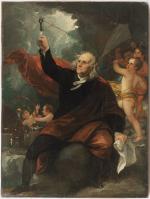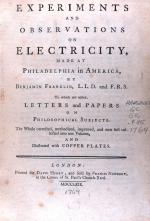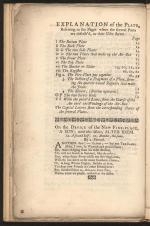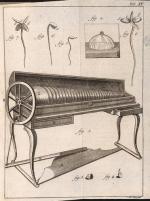![header=[Marker Text] body=[Printer, author, inventor, diplomat, philanthropist, statesman, and scientist. The eighteenth century's most illustrious Pennsylvanian built a house in Franklin Court starting in 1763, and here he lives the last five years of his life.] sign](http://explorepahistory.com/kora/files/1/10/1-A-392-139-ExplorePAHistory-a0m3v2-a_450.jpg)
Mouse over for marker text
Name:
Benjamin Franklin [Science and Invention]
Region:
Philadelphia and its Countryside/Lehigh Valley
County:
Philadelphia
Dedication Date:
June 30, 1990
Behind the Marker
Benjamin Franklin did not discover electricity, but he did experiment with it, study it, publish his findings, and become the world's leading expert on the subject. In describing electricity, he employed terminology still used today, including "battery," "charge," "conductor," "plus" and "minus," and "positive" and "negative."
This, however, was only a small part of his groundbreaking work. With the famous kite he flew during a thunderstorm in 1752, Franklin demonstrated that lightning is an electrical discharge. He was the first to identify the Gulf Stream, studied the motion of storms, and developed a theory on population growth. He invented bifocals, the Franklin stove, the lightning rod and the odometer. He was the first to suggest using something he called "summer time"; now known as "daylight savings time."
Franklin was also instrumental in establishing the institutions that advanced science and learning in the Commonwealth and the nation, including the Library Company of Philadelphia (1731), the first lending library in America; the Academy and College of Philadelphia (1740), which became the University of Pennsylvania; the American Philosophical Society (1743), which housed the nation's first patent office; the Pennsylvania Hospital (1751); and the Medical College at the College of Philadelphia (1765), the first medical school in the colonies.
One of the 18th century's greatest scientific minds, Franklin was the new Republic's most prominent member of an international community of mostly amateur scientists fascinated by the challenge of making sense of the natural world. Franklin was celebrated, honored and respected around the world for his many achievements, and he did it all with barely a smattering of formal education.
Born in Boston, Massachusetts, on January 17, 1706, Franklin only had about two years of schooling, but he was a voracious reader and learned much on his own. At seventeen, he left his brother's print shop to seek his fortune in Philadelphia, where he found work with a printer. Soon, he borrowed money, started his own printing business, and published the Pennsylvania Gazette, an important newspaper, and the popular Poor Richard's Almanack. He also became the public printer for the colonies of Pennsylvania, New Jersey, Delaware and Maryland. By the mid-1730s, Franklin was a wealthy businessman and civic leader. Then, at the age of forty-two, he retired from business to become a gentleman scientist, or as he put it, "to read, study, and make experiments."
Franklin's greatest scientific contributions came from his pioneering research in electricity. Finding that pointed conductors induced an electrical discharge faster than rounded ones, he was the first to make lightning rods with pointed tips and the first to electrocute a turkey. He discovered the principle known as the "Law of Conservation of Charge," which dispelled the idea that electricity is created by rubbing substances together. Franklin demonstrated instead that as one body gains an electrical charge from another, the second body loses the same amount as the first body gains. Franklin sent these and other observations to the Library Company's London agent, Peter Collinson, who passed them on to the British Royal Society, the most distinguished scientific body of the day. Published in 1751, Franklin's Experiments and Observations on Electricity was ultimately issued in five English editions and translated into French, German, and Italian.
electrocute a turkey. He discovered the principle known as the "Law of Conservation of Charge," which dispelled the idea that electricity is created by rubbing substances together. Franklin demonstrated instead that as one body gains an electrical charge from another, the second body loses the same amount as the first body gains. Franklin sent these and other observations to the Library Company's London agent, Peter Collinson, who passed them on to the British Royal Society, the most distinguished scientific body of the day. Published in 1751, Franklin's Experiments and Observations on Electricity was ultimately issued in five English editions and translated into French, German, and Italian.
Franklin's work made him an international celebrity and earned him numerous honors. In 1753, he received the prestigious Sir Godfrey Copley gold medal from the British Royal Society, and three years later was elected a society fellow. British scientist Joseph Priestley, whose own scientific efforts began with Franklin's encouragement, remarked in his
Joseph Priestley, whose own scientific efforts began with Franklin's encouragement, remarked in his  History and Present State of Electricity (1767) that the discovery of lightning as an electrical phenomenon was as "the greatest, perhaps, since the time of Sir Isaac Newton."
History and Present State of Electricity (1767) that the discovery of lightning as an electrical phenomenon was as "the greatest, perhaps, since the time of Sir Isaac Newton."
What set Franklin apart from many scientists was his practical bent. Insatiably curious, he also wanted to improve people's lives, a trait that originated with his Puritan New England upbringing. Franklin also was influenced by the philosophers of the Enlightenment, and believed that a better understanding of the natural world would help mankind. Thus, his scientific work and inventions were useful: his lightning rod protected buildings, his "double spectacles" (bifocals) improved vision, his Gulf Stream charts aided navigation, and his "Franklin stove" heated rooms better than a fireplace. Franklin also attempted to use electrical therapy to cure paralysis, and may have been the first to invent a medical catheter to alleviate difficulty in urination.
As the main force behind the American Philosophical Society, Franklin was at the center of the New World's most active community of gentlemen scientists, which included John Bartram, Edward Bromfield, Joseph Priestley,
John Bartram, Edward Bromfield, Joseph Priestley,  David Rittenhouse,
David Rittenhouse,  Benjamin Rush, David Wiley, Thomas Jefferson, and John Winthrop.
Benjamin Rush, David Wiley, Thomas Jefferson, and John Winthrop.
Franklin continued to study and analyze the natural world into his eighties, corresponding with his old friend James Bowdoin about the earth and magnetism, and the planet's geographic and magnetic poles. America's foremost scientist died on April 17, 1790, and was buried at Christ Church in Philadelphia. While many things have been named to honor him-bridges, counties, towns, townships, and so many more-he probably would have been most pleased by one: Philadelphia's Franklin Institute. Organized in 1824 to promote science and invention, the museum also received more than $100,000 from funds Franklin willed to the City of Philadelphia.
To learn more about Benjamin Franklin's political career, click here.
click here.
To learn more about Benjamin Franklin during the American Revolution, click here.
click here.
This, however, was only a small part of his groundbreaking work. With the famous kite he flew during a thunderstorm in 1752, Franklin demonstrated that lightning is an electrical discharge. He was the first to identify the Gulf Stream, studied the motion of storms, and developed a theory on population growth. He invented bifocals, the Franklin stove, the lightning rod and the odometer. He was the first to suggest using something he called "summer time"; now known as "daylight savings time."
Franklin was also instrumental in establishing the institutions that advanced science and learning in the Commonwealth and the nation, including the Library Company of Philadelphia (1731), the first lending library in America; the Academy and College of Philadelphia (1740), which became the University of Pennsylvania; the American Philosophical Society (1743), which housed the nation's first patent office; the Pennsylvania Hospital (1751); and the Medical College at the College of Philadelphia (1765), the first medical school in the colonies.
One of the 18th century's greatest scientific minds, Franklin was the new Republic's most prominent member of an international community of mostly amateur scientists fascinated by the challenge of making sense of the natural world. Franklin was celebrated, honored and respected around the world for his many achievements, and he did it all with barely a smattering of formal education.
Born in Boston, Massachusetts, on January 17, 1706, Franklin only had about two years of schooling, but he was a voracious reader and learned much on his own. At seventeen, he left his brother's print shop to seek his fortune in Philadelphia, where he found work with a printer. Soon, he borrowed money, started his own printing business, and published the Pennsylvania Gazette, an important newspaper, and the popular Poor Richard's Almanack. He also became the public printer for the colonies of Pennsylvania, New Jersey, Delaware and Maryland. By the mid-1730s, Franklin was a wealthy businessman and civic leader. Then, at the age of forty-two, he retired from business to become a gentleman scientist, or as he put it, "to read, study, and make experiments."
Franklin's greatest scientific contributions came from his pioneering research in electricity. Finding that pointed conductors induced an electrical discharge faster than rounded ones, he was the first to make lightning rods with pointed tips and the first to
Franklin's work made him an international celebrity and earned him numerous honors. In 1753, he received the prestigious Sir Godfrey Copley gold medal from the British Royal Society, and three years later was elected a society fellow. British scientist
What set Franklin apart from many scientists was his practical bent. Insatiably curious, he also wanted to improve people's lives, a trait that originated with his Puritan New England upbringing. Franklin also was influenced by the philosophers of the Enlightenment, and believed that a better understanding of the natural world would help mankind. Thus, his scientific work and inventions were useful: his lightning rod protected buildings, his "double spectacles" (bifocals) improved vision, his Gulf Stream charts aided navigation, and his "Franklin stove" heated rooms better than a fireplace. Franklin also attempted to use electrical therapy to cure paralysis, and may have been the first to invent a medical catheter to alleviate difficulty in urination.
As the main force behind the American Philosophical Society, Franklin was at the center of the New World's most active community of gentlemen scientists, which included
Franklin continued to study and analyze the natural world into his eighties, corresponding with his old friend James Bowdoin about the earth and magnetism, and the planet's geographic and magnetic poles. America's foremost scientist died on April 17, 1790, and was buried at Christ Church in Philadelphia. While many things have been named to honor him-bridges, counties, towns, townships, and so many more-he probably would have been most pleased by one: Philadelphia's Franklin Institute. Organized in 1824 to promote science and invention, the museum also received more than $100,000 from funds Franklin willed to the City of Philadelphia.
To learn more about Benjamin Franklin's political career,
To learn more about Benjamin Franklin during the American Revolution,
Beyond the Marker









